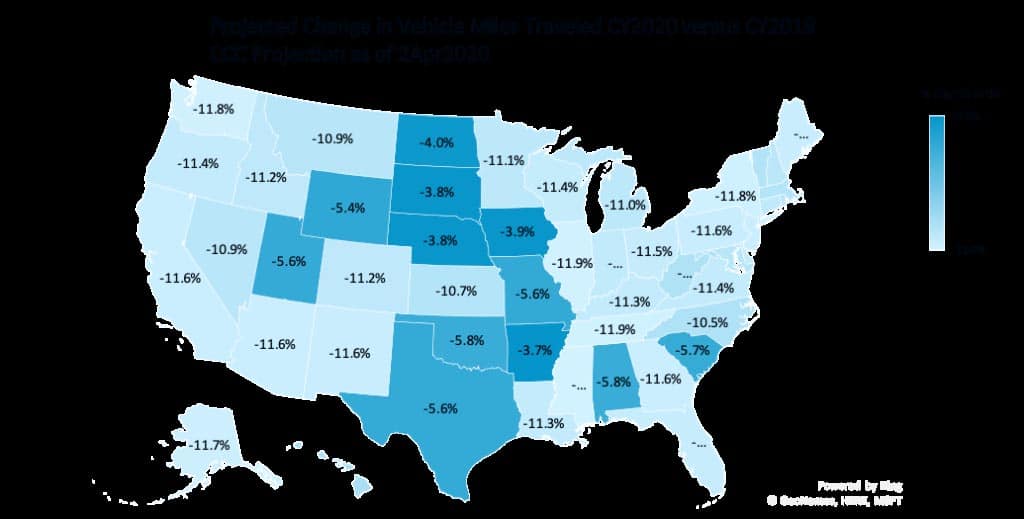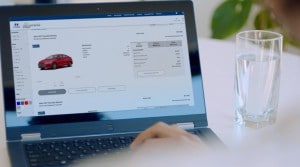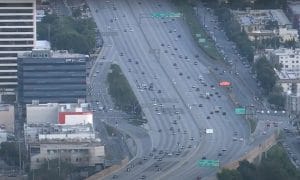For the small cadre of Los Angelinos who’re actually venturing out from home these days, hitting the highway can come as a shock. Traffic on typically snarled roads like I-405 is almost non-existent.
According to data from navigation service TomTom, Friday morning traffic in the City of Los Angeles ran barely half of what it would be in more normal times and, in recent days has been off by as much as 85%. The same is true for other major cities around the U.S., including New York, Atlanta and Chicago.
With lockdowns related to the coronavirus pandemic a major factor, American drivers are expected to not just drive less for all of 2020 but experience the biggest year-over-year decline in a full half-century, according to CCC Information Services.
(Silver lining? Coronavirus pandemic slashes traffic, sends gas prices tumbling.)
Though Americans tend to drive more each year – especially in the post-World War II era – the numbers have risen and fallen, typically in sync with the economy. Until now, the biggest decline over the past half-century followed the start of the Great Recession in autumn 2008.
As millions of Americans began losing their jobs and others hunkered down just in case, the country experienced an annual decline of 3.9% in miles driven, according to CCC, a company that provides “technology solutions” for the automotive, repair and insurance industries.
Right now, the U.S. is experiencing a double-whammy. There are the shelter-in-place orders that, to varying degrees, cover residents of all but eight states, over 300 million people, in all. If anything, the rules are tightening in many locales.
Michigan’s Gov. Gretchen Whitmer this week extended the lockdown through April 30 and closed numerous loopholes. Residents will no longer be allowed out to visit second homes and vacation cottages, for one thing.

A state-by-state look at how many fewer miles residents are expected to drive this year versus 2019. Source: CCC Information Services.
The lockdowns have closed most U.S. offices, stores and factories. But even where workplaces are open, there are likely to be fewer people on the job. This past week, 6.6 million Americans applied for unemployment, bringing to more than 16 the total job losses in just three weeks – about 10% of the country’s total workforce.
(Gas prices tumble as commuters stay home.)
For some, the situation could be short-lived. The auto industry, for example, hopes to begin restarting North American factories early in April. But sales aren’t expected to rebound for months, meaning plants will run slower than they had at the beginning of the year, requiring fewer workers for the time being. It is a matter of much debate how fast the broader economy will revive, especially if the extended lockdowns force many small businesses to close permanently – as is widely feared.
Even without the pandemic, there have been signs that Americans were starting to cut back on the amount of time they were willing to spend in their cars – and the miles they were going to be driving. Here, a number of factors are at work.

As more and more people get comfortable working from home, fewer and fewer will be willing to work in an office, potentially easing traffic congestion a bit.
- Government data show that today’s teens are waiting longer to get licensed, no longer viewing the process as an essential rite of passage;
- The emergence of online shopping, especially retail giants like Amazon, has translated into fewer trips to the mall. Indeed, there are fewer malls, as a result;
- Services like Postmates and Uber Eats are having a similar impact on dining;
- Though there is mixed data, some signs indicate mass transit is gaining ridership, and there are other competitors for the automobile;
- These include ride-sharing services like Uber and Lyft, as well as bike and scooter-sharing services.
Even when it comes to work, the number of employees who regularly do so from home surged from 4.3% in 2010 to 5.3% in 2018. And a Gallup study found 39% of Americans worked remotely at least occasionally.
“I think this is a watershed moment in terms of wider acceptance and implementation of work-from-home,” Philippe Weiss, president of Seyfarth Shaw at Work, the Chicago-based workplace training subsidiary of law firm Seyfarth Shaw, told the Chicago Tribune. “Employees that have tasted the benefits of more freedom and autonomy are going be hard-pressed to let it go.”
Whatever the reason, the downward trend in driving was already quite apparent before the pandemic put most everyone’s car in park. According to the Wall Street Journal, residents of Maricopa County, which includes Phoenix, have cut driving on a per capita basis by 7% since 2006, the Wall Street Journal reports, with Arizona overall seeing an 11% drop during that period, according to the state’s department of transportation.
(Gas prices not expect to rise despite Russia-OPEC deal.)
For the past two decades, it has become almost a cliché to say that America’s love affair with the automobile is over. The fact that U.S. residents last year exceeded forecasts, snapping up 17.1 million new vehicles and twice as many used ones, suggests that’s an overstatement. But it seems to be more accurate that American motorists are less enamored of being in their cars all the time, whether driving to work, the store, or out for the evening.

